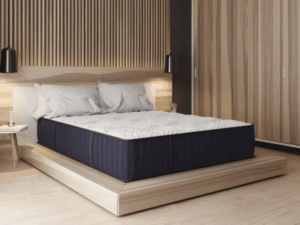What is Pressure Relief in Mattresses?
Disclosure: By clicking on the product links in this article, Mattress Nerd may receive a commission fee at no cost to you, the reader. Read full disclosure statement.
You want your mattress to be comfortable and supportive, but does that mean it has to offer pressure relief? Here’s what this common mattress term means and what to look for to find the pressure-relieving mattress of your dreams.
What Does Pressure Relief Mean?
Pressure points are the parts of your body where you feel the most pressure when you lie down. These spots vary depending on how you sleep. For instance, side sleepers tend to feel the most pressure in their hips and shoulders. Back sleepers can experience pressure pain in their hips, and stomach sleepers may notice it in their lower back or shoulders.
In a mattress, pressure relief largely boils down to how evenly your body weight is distributed. The more even the distribution, the less likely that pressure can build in specific points on the body.
Sufficient spinal support is another key consideration. A mattress that doesn’t maintain proper alignment can create tension in areas of the body, like the lower back.
Mattress Types and Pressure Relief
Materials, construction, and firmness will all affect the pressure relief of a particular mattress. It’s important to consider the materials used in the comfort and support layers of a mattress. This will give you an idea of the type of pressure relief you can expect for your body type and preferred sleep style. Here’s how some of the most popular materials stack up.
Memory Foam
Memory foam is often praised for its pressure relief–and for good reason. Because it’s a material that you sink into, it contours well to support the natural curves of the body. That’s what gives it that signature “hugged” feel. Memory foam isn’t a very responsive material, which means it takes some time for it to adjust to your body if you change positions. For some people, that can create temporary pressure and pain.
Hybrid
Hybrid mattresses combine coil support layers with thicker comfort layers, which can mean you get the best of both worlds. They tend to be a good option for pressure relief. High-density foams or latex in the comfort layers are contouring to cradle the body. Below, many hybrid mattresses feature pocketed coils that compress individually under pressure for support right where you need it. Zoned designs, which use heavier-gauge coils in specific areas, can offer even more support and greater relief.
Latex
Latex is another popular pressure-relieving material. It delivers an even contour to the body, which helps maintain proper spinal alignment. Latex is more buoyant than memory foam, so you don’t have the sensation that you’re sleeping “in” the mattress the same in quite the same way. It’s also incredibly durable. You might find it in either the comfort or support layer of a mattress.
Innerspring
Innerspring mattresses usually aren’t the best option for pressure relief. Their coil systems are typically connected, so they offer targeted support. Comfort layers in classic innerspring mattresses tend to be thin as well.
Airbeds
Airbeds are designed for adjustability. By adding or emptying the air chamber, you can customize the mattress to suit your personal needs and preferences. Many models pair this air chamber core with thick comfort layers. That makes air mattresses a good option for pressure relief.
Should You Look for a Pressure-Relieving Mattress?
You may want to consider a pressure-relieving mattress if you’re routinely waking up with aches and pains in your lower back, hips, shoulders, or neck. This can be an indication that your mattress isn’t distributing your weight well, which means the parts of your body that come into the most contact with the bed are supporting the majority of your weight. A pressure-relieving mattress will contour to these parts so that they sink in comfortably, without sacrificing spinal alignment.
People who spend a lot of time in bed, like those who are on bedrest, are particularly at risk of complications from pressure point, like bed sores. They’ll benefit from a pressure-relieving mattress.
How to Improve Your Mattress’s Pressure Relief
If your mattress isn’t offering enough pressure relief, you have a few options.
- Add a mattress topper. These layers are designed to add cushioning for greater comfort. By choosing a pressure-relieving material, such as memory foam or latex, you can change the firmness or your mattress and better support your body in your preferred sleep position.
- Experiment with adjustability. If your mattress can be adjusted, try experimenting with different firmness levels. Some flippable designs have different firmnesses on either side, and you may find pressure relief simply by flipping the mattress.
- Check your mattress foundation. Some mattresses aren’t designed to be used on certain types of foundations, so make sure to double check that you’re following the manufacturer’s directions. Without the right base, some mattresses can sag and compromise support.
Frequently Asked Questions
What type of mattress is best to relieve pressure points?
There’s no single best mattress for relieving pressure point pain. It will vary based on body weight, sleeping position, and your degree of sensitivity or pain. However, in general, memory foam mattresses, as well as hybrid options with memory foam in the comfort layers, are a good option for relieving pressure pain. Memory foam contours to the shape of your body for deep cushioning around the hips, shoulders, knees, or any other that needs cradling support. Latex is another good option, especially in a hybrid mattress.
What types of mattresses prevent pressure sores?
If you need a mattress to help prevent bed sores from forming, an air mattress is likely the best option. One study found that these types of mattresses may be more effective at reducing pressure-induced sores than foam surfaces.
Is memory foam good for pressure relief?
Memory foam is a good material for pressure relief because of the way it molds to your body as it warms. A mattress with high-density foam or sturdy innersprings in the support layers and memory foam in the comfort layers can be a good combination for pressure relief.
Takeaway
Waking up with aches and pains is a terrible way to start your day, and a mattress with good pressure relief may be able to help. Materials like memory foam and latex, along with hybrid constructions, can offer the contour and support you need to cushion the parts of the body that come into the most contact with your mattress, without sacrificing proper spinal alignment.
Resources
Shi, C. et al. (2021). Beds, overlays and mattresses for preventing and treating pressure ulcers: an overview of Cochrane Reviews and network meta-analysis. https://www.ncbi.nlm.nih.gov/pmc/articles/PMC8407250/


